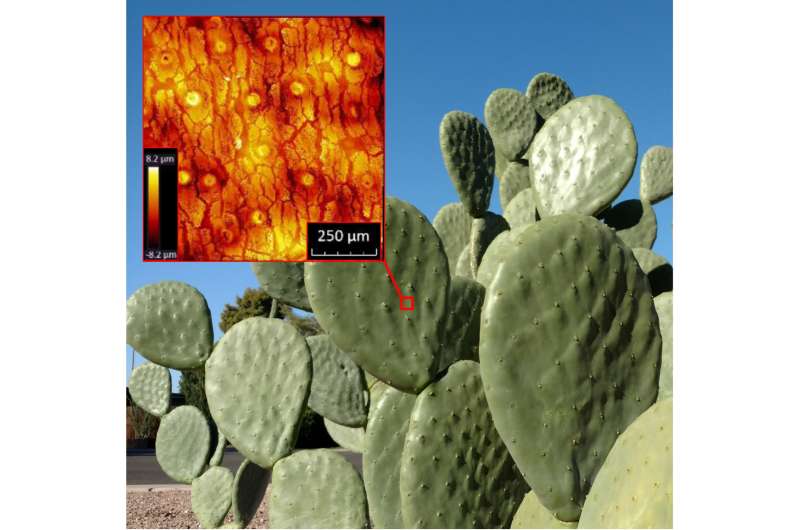What smart hazmat suits and Sonora cactus skins have in common

When Konrad Rykaczewski moved to Arizona's Sonora Desert region six years ago he took a water bottle and sprayed the plants in his front yard, not to water them, but to see how they interacted with water droplets.
"It was the first time I'd lived in a desert, and I was fascinated by the flora and fauna," Rykaczewski said, a professor of engineering at Arizona State University in Tempe, Arizona. "What I noticed about prickly pear cacti is that the new pads are superhydrophobic, but the ones a season older right below them are superhydrophilic. I wondered why."
Rykaczewski began to look at desert animals, including rattlesnakes that change shape to drink water from their skin. Motivated by his front yard observations, Rykaczewski recruited students and with a seed grant from ASU's Biomimicry Center began experimenting in the laboratory to characterize the cactuses' microscopic 3-D epidermal structure at dry and wet times of the year. Rykaczewski applies the lessons in wettability—the study of how droplets interact with solids—to engineering surfaces for industrial applications.
Kenneth (Chad) Manning, a doctoral student on the project who led the experimental work, will present the team's discoveries from this Sonoran wettability research at the American Physical Society's Division of Fluid Dynamics 71st Annual Meeting, which will take place Nov. 18-20 at the Georgia World Congress Center in Atlanta, Georgia.
They discovered that while new cactus pads (cladodes) have a continuous waxy, hydrophobic surface, older ones are covered with a network of microcracks "that go down all the way through the wax to the cell wall," which is hydrophilic, explained Manning.
Using high-speed video, the researchers documented that water droplets bounce off young, waxy pads, but with older pads the microcracks exposing the inner hydrophilic surface cause water droplets to hit and stick. "The skin is acting as a smart membrane," said Manning. "As cacti dry out the cracks close, helping to preserve water."
The results are now informing Manning's research to develop a smart material for hazmat suits. The pores of the material will close in the presence of dangerous chemicals but will otherwise remain open allowing for vapor and heat transfer out of the hazmat suit, a factor which currently limits their use.
It's a smart-skin trick prickly pear cactuses have already finessed. "It's the same sort of change in the surface morphology," Manning said.
More information: Presentation F13.8, "Droplet Interactions with the Prickly Pear Cactus and Western Diamondback Rattlesnake of the Sonoran Desert" by Kenneth C. Manning, Praveen Kotagama, Akshay Phadnis, Gordon W. Schuett and Konrad Rykaczewski, will be Monday, Nov. 19, 9:31 a.m. in Room B218 of the Georgia World Congress Center in Atlanta. Abstract: meetings.aps.org/Meeting/DFD18/Session/F13.8
Provided by American Physical Society





















